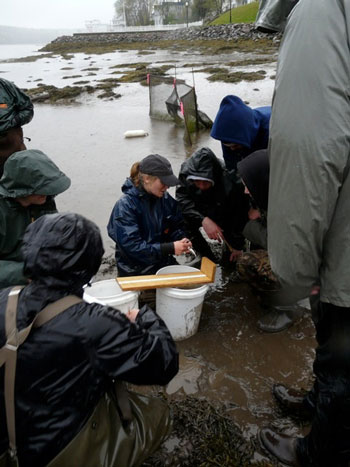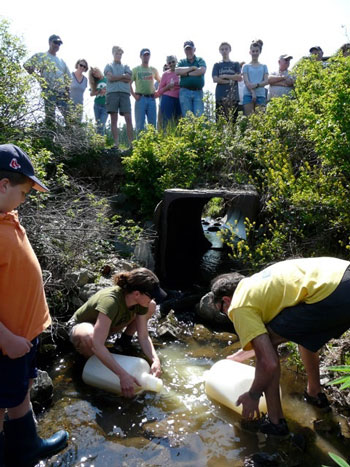Smelt Return!
by Charles Curtin and Kate Hotchkiss Taylor

DMR biologist Claire Enterline demonstrates recording methods to North Haven Community School (NHCS) students during capture in May in a stream near Bucksport at the head of Penobscot Bay.
A small batch of smelt returned to North Haven in June, part of series of near-shore restoration projects contributed to by community members, the Department of Marine Resources, and the school. The last time smelt swam in the waters of the island was over thirty years ago, and fishermen especially are hopeful the return “sticks”. Smelt are a small sea-run fish that live as adults in salt water and spawn and hatch in fresh water streams. Similar to the better known alewife, smelt are also important as the base of the food chain and a key forage fish that is consumed by larger fish. This means that the restoration of both fish is absolutely critical for jump-starting near shore environments and in helping return richness to near-shore waters.
Smelt not only add to ecological health, they also contribute to the region’s cultural heritage: "Smelting" was a common right of passage and family event up and down the coast for centuries as people gathered to capture the small fish in local brooks each spring. Though there are still a few smelt runs left, they are getting more rare: According to local fisherman Peter McDonald, on North Haven the fish were last captured in 1978. McDonald, who has actively lobbied for the return of the fish for many years, says the population was strong throughout the early 1970s and then declined sharply after 1976. The reason for the fish’s demise is unproven and unsure, but local fishermen associate it with a period of intensive fishing pressure. DMR smelt biologist Claire Enterline sees it as perhaps being related to a larger regional decline, causes which are also unknown.

NHCS principle Barney Hallowell and science teacher Kristen McGovern release smelt hatchlings into a local brook on North Haven where the fish were last seen over 30 years ago.
Though there have been fishery restorations attempted on North Haven stretching back decades, for Dr. Charles Curtin, a restoration ecologist at Antioch University and year-round North Haven resident coordinating their return, the interest in this smelt work arose from working on Cod conservation with McArthur Genius Award winning fisherman Ted Ames. Ames is fond of saying, "No food - No fish," highlighting the importance of smaller sea-run fish in bringing larger species such as cod and salmon back to their original habitats. On North Haven, Curtin's leadership stretches to a 2005 ferry conversation with Peter McDonald, when Curtin was asked, “Why the heck are you working to restore offshore species such as cod, when the island was still missing such an important part of its heritage?” So started a seven-year effort to bring fish back to North Haven, culminating in back-to-back alewife and smelt (see North Haven to Alewives: Welcome Back! by Catherine Schmitt http://www.workingwaterfront.com/articles/North-Haven-to-Alewives-Welcome-Back/14367/. These programs are seen by Curtin and others as a learning process to help restore the fish up and down the coast of New England, a result critical to the survival of multiple fishing industries and the health of the sea.
Unlike the alewife introduction that brings in adult fish from nearby river systems to spawn and lay eggs, with smelt the time-honored approach has been to spread burlap bags over rocks in smelt brooks, and then move the bags, with newly spawned eggs, back to other brooks to spread the populations. This method has led to a more sophisticated approach that uses specially designed "tiles" to collect those precious eggs. According to Enterline, the problem with this technique is that this also collects pathogens or exotic species that may be in the donor creek. In a relatively pristine location such as North Haven this was considered too great a risk. In 2010, Dr. Curtin therefore investigated the possibility of using hatchling smelt for a release, but the cost was prohibitively high, existing stocks may not have been of the right genetics, and the there may have been relatively low retention of adults in the recovery streams.
Enterline then introduced Curtin to a technique developed at the University of Massachusetts to raise smelt in the lab developed by Matt Ayer and his colleagues. Enterline and Curtin co-authored a grant to the Maine Outdoor Heritage Fund to raise the smelt at the North Haven Community School with Enterline and Ayer providing expertise to help undertake the process outside of a large research lab – the first time a school has ever been given this honor and responsibility. Science teacher Kristen McGovern and her high school students, with the support of principle Barney Hallowell, local fisherman Adam Campbell, and additional community members, undertook the process. Equally enthusiastic students, teachers, and mentors captured the fish in the wild in mid-May, and their eggs and sperm were extracted in the lab and held in a system of aerated small tanks that mimicked natural streams.
Ten days later, after the eggs hatched, the fry were released into the wild in the last stream to have had smelt in the 1970s – a location chosen over seven other options due to its likelihood of success. With the smelt successfully released, the community must now patiently wait for another year to see if the fish return. Meanwhile, the lab propagation and release will continue for several years in order to establish the fish in their reclaimed environment. This hopeful return of the smelt is another shoreline restoration process exemplifying how island communities and fishermen are forging their own – and their children’s – futures by the sea.
